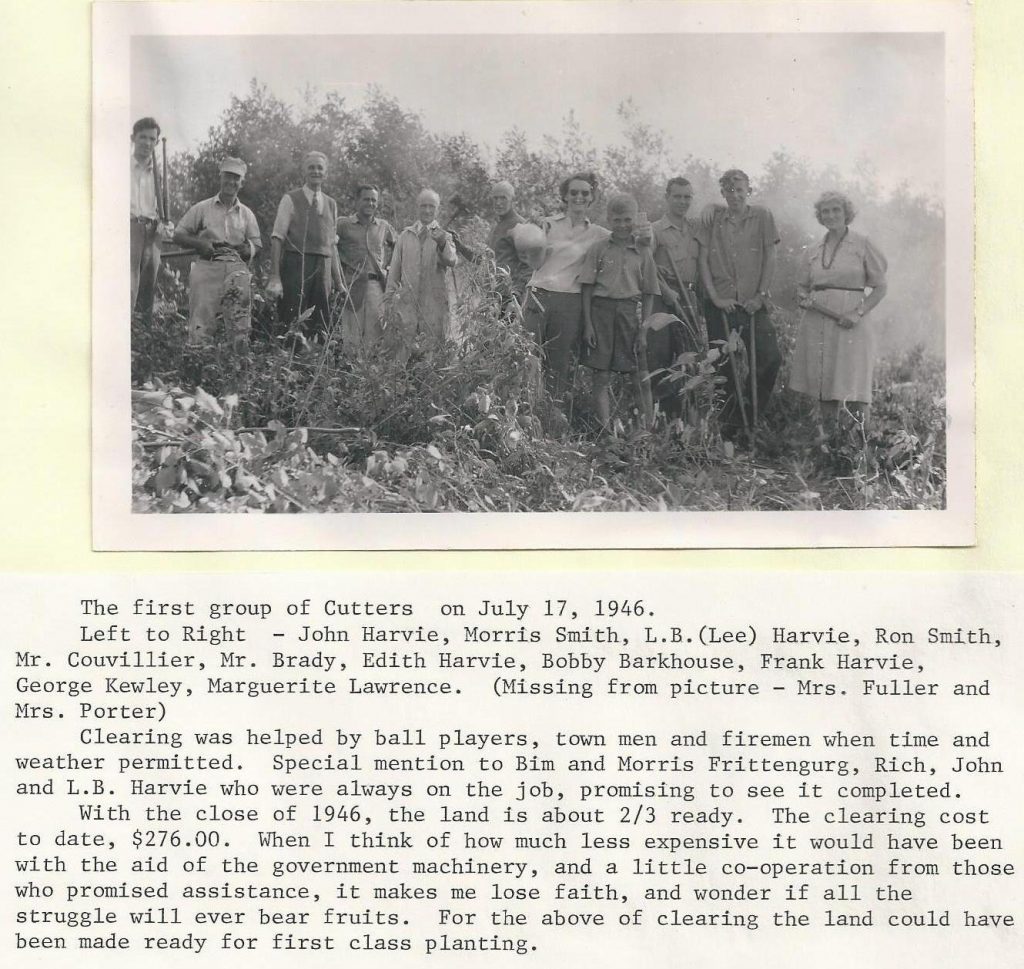Originally printed in “The Graduate” – Hantsport High School Yearbook, 1974
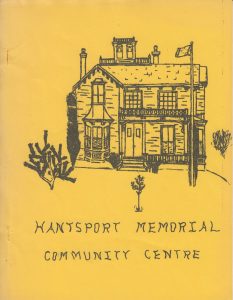
HISTORY
OF
HANTSPORT MEMORIAL COMMUNITY CENTRE
PREFACE
In preparing this report we were greatly aided by Mr. Ben Alexander. We would like to express our thanks to him for the kind use of his records and his memory.
After this report had been printed, we discovered an omission: the fact that Mr. Jerry McElhiney served as Sports Director in 1967. Now we are afraid that there may be others we have not noticed and possibly there are errors in events and dates.
If you find one, count yourself lucky that you can remember. So often we have heard, “I didn’t know that”, as someone read a portion of our report and surprisingly, many of the younger and newer townspeople do not know the history and development of our Community Centre. This is our reason for writing this report and we proudly present it here.
Leland Harive ’74
Karen McDonald ’74
Lorraine Smith ’74
Karen Wilcox ’74
PRESIDENTS
OF
HANTSPORT MEMORIAL COMMUNITY CENTRE
J. J. Jodrey 1948-1956
R. J. McGrath 1957, 1958
W. F. Mulhall 1959, 1960
C. A. McKinnon 1961, 1962
D. R. Parsons 1963, 1964
A. R. Clark 1965, 1966
L. D. McCully 1967, 1968
W. H. Gates 1969, 1970
G. R, Sircom 1970, 1971
A. L. Harlow 1972
L. L. Dillman 1973, 1974
Inception, House and Grounds
In the late 40’s Hantsport was a growing town with many new families. There was little in the way of organized recreation and that need was recognized by the groups active in the town. Mr. Ben Newcombe of Wisconsin made a gift of $5000 to build a community pool. Swimming pools were not as common as they are now and the idea started much talk around the town. The Hantsport Women’s Institute discussed the idea of having a civic building in which the town office could be housed and of building the pool in the surrounding recreational area. The civic building would be the heart of town and provide space in the basement for groups and organizations to meet. The marshy field behind the Catholic Church was the site chosen because the land belonged to the town and work parties were formed and began clearing the site of bushes and stumps.
The Women’s Institute began a fund raising campaign and planned to start the basement and then turn the project over to the town. They raised the striking sum of $2000 which they turned over to the Community Centre after it was formed in return for the use of one private room in which to meet. A Civic Development Committee was set up in the town to discuss the project. Mr. Newcombe came up here to see how things were progressing and was all in favour of moving the project to the 18 acre Churchill Property which was for sale. After some bargaining the purchase was arranged in 1948 with Mr. Burgess, who held the property at that time. A $10,000 down-payment was given by Mr. R. A. Jodrey and a mortgage was taken on the rest. The project was incorporated and the name given was the Hantsport Memorial Community Centre. Officers were appointed and the organization was launched on it’s way.
The following is a description of the Churchill House reprinted from “Seasoned Timbers”, a publication of the Heritage Trust of Nova Scotia. It was called “The Cedars” because of those stately trees which lined the drive.
“THE CEDARS” Hantsport, Hants Co.
In the days of sail, the Churchill shipyard in Hantsport was one of the most important in the Maritimes, and in its heyday it was the fifth largest in the world. The Churchills trace their
descent to John Churchill who was at Plymouth, Mass., in 1643. They moved to this Province in l764. Ezra Churchill founded the Churchill fleet of sailing ships, one of these was the “Hamburg”, the largest Canadian three-masted barque ever to have been built in this country.
Ezra had a numerous family, fourteen children, and it was during his lifetime that he built “The Cedars: for his second son John Wiley, employing his Shipwrights. The house stands on a knoll and was built around 1860. The outside is a rather unassuming frame structure. It is large, square, typically Victorian with balconies, fretwork, and as to be expected a widow’s walk. The carriage house has a charming belltower. While the outside appears to be only prosperous and conventional, the inside offers many surprises. The wide front door, with coloured glass insets on either side, opens onto a hall. The ground floor contained the large kitchen, staff rooms and a nursery with a frieze all around the wall depicting the best known fairy-tales in a manner that must have delighted the many young occupants. Going upstairs, the wallpaper on the landing is hand-tooled leather from Italy. There is a mural showing an old man bringing home his departed daughter – a real period piece. The drawing-room runs the length of the house, three rooms running into one another. The fine moldings on the ceiling were made from molds made by a village mason who copied designs from ships. The plaster walls are painted with watercolor in a rose design. The archways between the rooms are framed with a fretwork of superior workmanship. The floor is inlaid and on it is a pale green carpet. The three delicate crystal chandeliers in these rooms were imported from France. The Churchills were very musical and understandably the third part of the drawing-room was the music room. The ceiling here was broken through forming a balcony along three walls. In this room on one of the walls on brown and gold paper is the coat-of-arms.
When Ezra built “The Cedars” for John, he had time and money to make the house a showplace. Large trees bordered the property, the gateposts marked “C”, were made of local stone. There was a summerhouse, well tended flowerbeds, a pond with a small island and a greenhouse near the stables. Lining the driveway at twenty foot intervals were three foot high model houses, each one with a different design from the previous one. These had been made by Silver, a Portuguese sailor who left the sea to become (a) Coachman.
The last to live in the house were John’s two daughters Violet and Laura. At their death the house became community property and is now used as a community centre.
Page 50, “Seasoned-Timbers”
The Heritage Trust of Nova Scotia
Halifax, N.S.
In the few years after the purchase there was a lot of talk about the house and what could be done with it and there was some thought of tearing it down to make room to construct a Community Hall with seating space for large meetings and which could also be used as a gymnasium and have rooms for other uses in the basement. A plebiscite was held on this proposal and the results were 243 in favour and only 20 opposed. Fortunately the plan was never implemented and the historic building was not disposed of. Extensive repairs were made and the building modernized. The roof, chimneys, gutters, verandahs, railings, and windows were repaired or renewed where necessary. The kitchen was remodeled and renovated to provide an efficient area to cater to affairs and a new heating plant installed in 1958.
The lawn and grounds of the Centre have had much work done on them. An outdoor pavilion was constructed for dances and concerts; The front lawn was leveled and landscaped and three flower beds were planted by the Garden Club. Lawn furniture was also constructed and painted. A special fund was started by Mr. R. A. Jodrey to cut and remove old and broken trees and branches and plant new ones on the grounds. The Tree Planting Committee was assisted by the Boy Scouts and Wolf Cubs in planting red spruce and pine trees in selected locations. A grove of Norway spruce and pine were planted in the swimming pool area in 1956. Maples and elms were also planted. Yews and pyramidal cedar were planted and the Women’s Institute donated a flowering crab which stands in the centre of the front lawn. Recently trembling aspen have been planted around the drive and to commemorate Joseph Howe a line of spruce and pine were planted in 1973.
Accomplishments of the Grounds Committee over the years of operation include an extensive night lighting system, a new entrance gate in 1963 and repairs to the barn as well as cooperation in building the playground, tennis courts, swimming pool, rink, and race track. The driveways were graveled up until 1970 when the roadways and parking lot were paved.
For the 1967 Centennial Year the restoration of the main floor of the Community Centre House and the establishment of a Marine Memorial Room were undertaken as a town project. The Community Centre contributed by providing space and money in the amount of $4000. The greater part of the cost was shared by the government. The Marine Memorial room contains relics and information on the shipbuilding industry of Hantsport and was officially opened on July 3rd 1967 and is open to the public daily through July and August. A bronze plaque was unveiled on the front veranda of the H.M.C.C. house by Mr. H. Mills, Director Centennial Commission.
In 1973, a government grant was obtained by the Community Centre to help in the clearing of brush from the bank overlooking the Halfway River and the establishment of a pleasant walk and picnic area.
July lst
Dominion Day celebrations had been held in the town before the establishment of the Community Centre. Suppers were held in the old Scout Hall which stood where the new school is now and street dances were held at night on Station Street. After the purchase of the Churchill property the centre of the celebrations moved over in the form of a community fair. This was in 1948 and the fair grew and changed over the years since that time.
Booths were set up on the grounds and bingo games and dances held. The workers were fed right on the grounds so there wouldn’t be any lost time. The variety of the games is illustrated by this list of l964: coin ring toss, wheel game, darts, novelty booth, turtles, hoopla, high striker and ball throw, crown and anchor, cane game, rabbit game, horse race, beat the dealer, raffles, and bingo. The Beazley Memorial Road Race was originally much longer but in 1956 when it was run on the race track it was shortened to 5 miles. The Soap Box Derby which was popular with the younger set and had them out building their ‘winning’ carts in preparation for the big race which ran on Holmes Hill for many years. Problems with the street paving and the slope of the hill caused the cart races to be discontinued after 1966. The Children’s Parade in the morning from the school and around the wading pool became an annual event and all mothers can remember decorating a doll carriage or wagon at some time.
The Grand Street Parade became a tradition that was quite a challenge to surpass each year. Bands from all around the province have performed and the decorated floats from the Apple Blossom Festival as well as commercial and organizational floats and groups of majorettes made up the main event of the day. After the parade the fair grounds offered refreshments, games of skill and chance, cotton candy, and rides over the years have included kiddies train ride, water swing, merry-go-round and for the first time in 1963 a ferris wheel.
Exhibition baseball games between our own Shamrocks and visiting teams provided entertainment in the afternoon. Legion Suppers were held and the fireworks display although costly is looked forward to each year and was taken over by the town in 1967. The day ended with tired workers for the fair was the product of a lot of work and planning by the committees, organizations and groups that assisted in the operation.
The fair grew in size and profit each year and by far the biggest was July lst, 1967. The activities and events were spread over a nine day period with a Centennial Dance on Friday June 30th, flag ceremony, children’s parade, track meet, Beazley Memorial Race, Community Fair, Main Street Parade, teenage dance, old time dance and fireworks on Saturday, July lst, Monday July 3, Centennial Project opening Tuesday July 4, Students’ Day, Wednesday July 5, Legion Day Thursday July 6, Town Picnic on the Community Centre grounds, swim meet, novelty races, beautiful baby contest and record hop, Friday July 7 was Sportsmen’s Day and an old time dance was held on the C.C. bandstand on Saturday July 8.
The record profit of 1967 was surpassed in 1968 due to reduced costs and better operation and the tremendous popularity and reputation attained in the valley area. The Fairs of 1969 and 1970 kept up this new scale of operation and profit. A radio operated aircraft display was featured in 1969 and three bands including the C.F.B. Band from Greenwood performed in the 1970 parade. In 1971 several changes were made in the programme. There was no street parade and fewer games. New attractions such as a Tug of War competition, a Little League baseball tournament and a country and western dance were added. Rain interrupted the dance which quickly moved indoors to the school auditorium. The 1972 Fair continued the new style of fair with Queen Annapolisa attending to celebrate the 25th anniversary of the Fair. The Kentville Firettes led the Children’s Parade. Also a horseshoe tournament was held but the day was marred by rain which caused some of the events to be carried over to Monday the 3rd also a holiday. In all the years of operation on only a few has it rained on our July 1st. In 1973 the Children’s Parade was moved to the afternoon. There was a pie eating contest and an antique auto show. 1973 was the centennial of the R.C.M.P. and there was a Caravan display for view on the Fairgrounds.
Swimming Pool
Building of the swimming pool, the project which was the reason for the Community Centre, was not immediately carried out because of the financing for the Churchill Property. In 1954 work began on the plans of Mr. Doug Weber of Halifax under the supervision of Mr. Ben Alexander. Work continued through 1954 and into 1955.
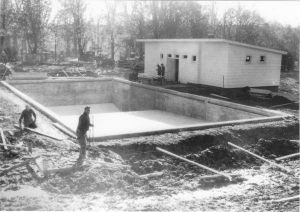 |
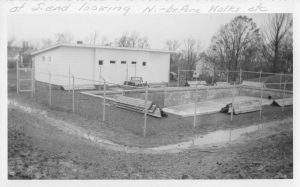 |
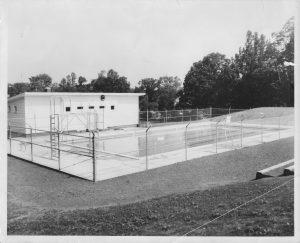 |
The pool was one of the first regulation size, outdoor community pools in Nova Scotia and also one of the best of those which have been since constructed. The foundation, draining and reinforcing were carefully planned and carried out. The resulting debt was paid off in five years with special fund raising campaigns and donations by business, industry, citizens and groups.
The first supervisor was Mrs. Jocelyn Fraser of Wilmot, Annapolis Co. who served for the five seasons between 1955 and 1959. All school age children in Hantsport, Mount Denson, Hants Border and Lockhartville were able to register for swimming classes and general swimming. Of the 337 enrolled 314 took regular instruction in 1956. A season’s total of 12,421 swims were recorded. A swimming team was formed and because ours was a regulation size pool most of the first meets were held in Hantsport. The team in 1956 was made up of 12 boys and 22 girls. They won a total of four trophies, the Halifax Herald Trophy; Beazley Trophy; Lunenburg Kiwanis Cup and the Evans Trophy, in the Junior and Senior Provincial Outdoor, and Western N.S. Meets. The season ended with a water show which has become annual.
In the years of operation the number taking instruction has grown from 259 in 1955 to 494 in 1972. Voluntary assistance was given at first until permanent instructors were hired. The value of swimming instruction and children learning to swim skillfully was undisputable. Adult swimming instruction was also given. In 1959 Mr. Ben Newcombe sent a bronze plaque for the pool building.
Bill Preston, former assistant to Mrs. Fraser was pool supervisor in 1961. The number of swims increased from the 12,000’s in 1955 to over 17,600 swims in 1963 when Douglas Sitland of Halifax became pool supervisor. Frank Barteaux served as supervisor from 1967 to 1969. The new pool administration office was completed in 1968. Janet Johnson became pool supervisor in 1970 and continued until 1973 when Pam Creaser became chief administrator.
Children’s Playground
An area for children to play was set aside in 1952. The Wading Pool and fountain, the sand boxes and the swing sets were the first equipment provided and the playground proved popular. A playground committee was formed and many things were planned and improvements made. The Board of Trade promoted and sponsored supervision of the playground and Mrs. Marion Phillips and her daughter were the first supervisors in 1956. Other groups and industry contributed to make this possible.
In June 1956, the Lucknow Branch of the Royal Canadian Legion donated $200 for new equipment. The money was put into the two merry-go-rounds which were much appreciated. During the next year a new ‘Climber’ was installed, built of used pipe.
Fund raising by the Playground Committee included a fashion show and entertainment night in 1963 and profits earned by these means have been put into new equipment. In 1964 the playgrounds were improved with the addition of flush toilets and dressing rooms and a new giant slide. The next summer glider swings were installed for the younger children. The cement crawl-through tunnels were donated by the Hantsport Firemen in 1971.
Supervised play and the many pieces of equipment as well as the wading pool make the Hantsport Memorial Community Centre Children’s Playground a popular place for the younger set during the summer months.
Teen Age Club
During the early years of the Community Centre a Teen Age Club was formed which held dances and provided entertainment for the youth of the town. The Wolfville orchestra provided music at first but were unable to continue. The Community Centre bought a good quality record player and Club held a Pantry sale to raise money to buy new records in 1956. The ‘Teen-Agers’ assisted at the July lst Fair and officers for the year were elected as follows; Carol Harvey, President, Mary Lou Dewer, Vice-President, Hazel Banks, Secretary and Marilyn Starratt, Treasurer.
In 1958 weekly dances were held with the music provided by an orchestra made up from among the local young people. The name of the group was ‘The Rebels’. The program was reduced over the summer months with weekly dances resuming in September. The club voted $25 to the Springhill Disaster Fund.
In 1959 the groups regular activities were carried on. During the summer three dances were held. The dances were held on Saturday afternoon instead of the usual Friday night with music provided by ’The Saints‘. The Club gradually dissolved after this time.
In April 1968 a Coffeehouse was operated in the barn for the youth of the town. It was sponsored in part by the four churches and each Saturday night was open for card games and other recreation. It continued through that season.
Ladies Auxiliary
At the annual meeting of the Community Centre in 1958 the Ladies Auxiliary were incorporated into the bylaws. The Auxiliary had been in existence for over two years and the value of their work was already well known. They have catered to weddings, banquets, luncheons of organizations such as the Eastern Star and Rotary and have sponsored coffee parties, teas, and bridge parties. The profit realized from these endeavors is turned over to the Community Centre. In 1957 a Bread Baking Contest and Variety Show was held on September 25th, sponsored by the Ladies Auxiliary and Purity Flour. There were 143 loaves of bread entered and prizes were awarded as follows: 1st to Mrs. A. Weatherby, 2nd to Mrs. D. Wellwood, and 3rd to Miss Mary Clarke. Other projects of the Auxiliary have included operation of the Canteen on July lst, the baked bean suppers for the Winter Carnival, a handicraft show, the purchase of a fridge for the kitchen of the Community Centre House, and have sponsored the Hantsport Apple Blossom Princess and assisted with her wardrobe. In 1973 they presented a Fall Dance.
Each year the amount contributed to the operation of the Community Centre is greater and so is their value to the town as a whole. Meetings on the first Monday of each month were held up until 1969 when they were replaced by an annual meeting. Officers and convenors are chosen and business and financial reports made.
Millage Oulton Memorial Library
The estate of the late Grace Burgess Oulton was left to the Hantsport School Board to set up a library to be known as the Millage Oulton Memorial Library. It was decided by the board that an independent library could not serve the community as well as a branch of the Annapolis Valley Regional Library. The Library was housed in the Community Centre House. Two rooms on the second floor were redecorated and reading tables and chairs were installed. One room contained children’s books and the other books for adult readers. Miss Elmira Borden served as librarian.
The Library opened in December 1957, and total registered membership grew from 335 to 500 borrowers after two years of operation. The Library moved to its new home in the new school building in 1961.
Tennis Club
There was in 1956 and 1957 a group of townspeople interested in forming a tennis club. They met with the Community Centre and obtained permission to operate on the centre grounds and some financial assistance for their project. There were difficulties in setting up the tennis courts because of a shortage of workers and because it was late in the season. The courts were carefully laid out and a clay surface covered the playing area.
The second court wasn’t finished until the next year and because the official opening had been rained out it was held then, in 1958. Officers elected for the season were; Eric Smith, president, Patsy Anderson, vice-president, Donna Wood, secretary, and F. Ainsworth, treasurer. Thirty-three Junior and 25 Senior members were registered and the season was reported a success.
The 1959 season was a very wet one and membership and use of the courts declined. In 1961 a Tennis Tournament was held and three trophies awarded. Repairs were made to the courts in 1963 and the club enjoyed one of its most successful seasons. Tennis instruction was given by Dave Crabbe on each Tuesday and Thursday and tennis remained an important summer activity at the Centre in 1964, 65, and 66. Trophies won in that year were Senior Boys, Denny Johnson, Junior Boys, Bill Johnson and Girls, Sharon Murray.
After this time interest in the club fell off and unfortunately the courts fell into disrepair. In August 1971 three horseshoe pits were constructed on the tennis courts. A tournament was held on Labour Day of that year. Horseshoes proved to be popular and in 1972 the number of pits was increased to six. Tournaments were held on July 1st and again on Labour Day as they were again in 1973.
Flower Show
The Hantsport Garden Club held annual Flower Shows at the Community Centre House starting in 1954. The show was usually held in August and was always well attended. Entries of flowers and vegetables were judged and prizes awarded at the 9th Annual Flower Show in 1957 were as follows: Pansies, winner, Grace Blackburn, Roses, R.W. Zinck, Sweet Peas, Jimmy Sherwood, Living Room Arrangements, Mrs. W.T. Cohoon, Gladiolus, Mrs. Ted Patton, Flowering House Plants, Annie Pearman and the prize Vegetable Collection was entered by Ted Johnston. The Women’s Institute served tea at the show which carried on through the afternoon and evening. Some of the entries were auctioned off by Alex Stevens.
The Race Track and Sports Field
In 1956 the back field was leveled off to form a ¼ mile track and place for ball fields which were not developed until later. For the 1958 July lst Road Race the Legion placed a layer of cinders on the course and the race was run on the new track.
In 1961, Bob Burchill was made director of recreation and a Little League Baseball Diamond and a Volleyball Court were constructed. Repairs were made to the existing Softball Diamond. The Little League was made up of 53 boys and divided into 4 teams although there were only uniforms for two of them. Trophies were awarded to the most valuable and most improved players. A girls’ softball team played twice a week and extensive use was made of the Volleyball Court.
Ray Harris acted as director of recreation in 1963 and a Sports Committee was set up. New uniforms were supplied by the Hantsport Home and School Association. In 1964, 74 boys played and an all-star team made a trip to Middleton where they won over the Middleton all-star team. A Little League Tag Day was held to raise money. Use of the Volleyball Court disappeared from the list of activities in 1966.
Softball was another activity and there were two teams, one made up from the Canadian Keyes Fibre employees and the other a Hantsport town team. They played in the Windsor and District Softball League and ended up league champions.
The Glooscap Archery Club set up their range on the Community Centre grounds in the summer of 1966 and have continued to operate each summer.
Mr. David MacInnis served as sports supervisor from 1968 to 1971. In 1972 the sports program was under the direction of Mr. Gordon Johnson and Terry Skipper who carried on in 1973 with Richard Kenny to look after the Pee Wee, Little League and Bantam Baseball, and with John Bishop and Gordon MacBurnie looking after the Midget team, Mrs, Zelda McLellan assisted with the Girls’ Softball program.
Skating Rink and Winter Carnival
An ice surface was provided in the winter season of 1961 and the idea for a permanent outdoor rink came about. Construction began in September of 1963 with Cecil Scott as head of the Construction Committee. It was built with the dimensions of 165′ by 73′, proportional to the regulation size of 200′ by 85′. Heated dressing rooms, lighting for night skating and music were provided. Hockey instruction has been promoted over the years with many boys attending.
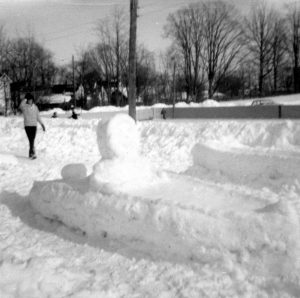 |
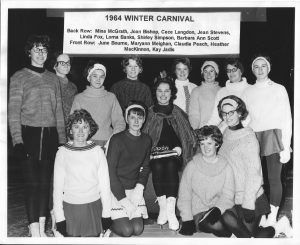 |
The first Winter Carnival was held in January 1964. Carnival Chairman was Mr. Curtis McKinnon and the carnival featured a parade around the streets, a bean and scallop supper at the Centre House, and an ice carnival with prizes for costumes, Sculptures were judged and Ice Queen chosen. A moccasin dance in the School Gym ended the Carnival which proved so popular that it has become an annual event, Since then hockey and broomball games, snowshoe races, snowmobile and sleigh rides and the bonfire have been added to the program. In 1972 a snowman building contest and an art contest was promoted and the Ice Carnival was moved to the afternoon.
Winter Carnival Queens
1964 – Claudia Peach
1965 – Arlene Burden
1966 – Linda Schurman
1967 – Anne MacBurnie
1968 – Susan Turner
1969 – Candice Shay
1970 – Pauline Hancock
1971 – Anna Kenny
1972 – Joanne McGinn
1973 – Donna Barkhouse
1974 – Patty Fraser

